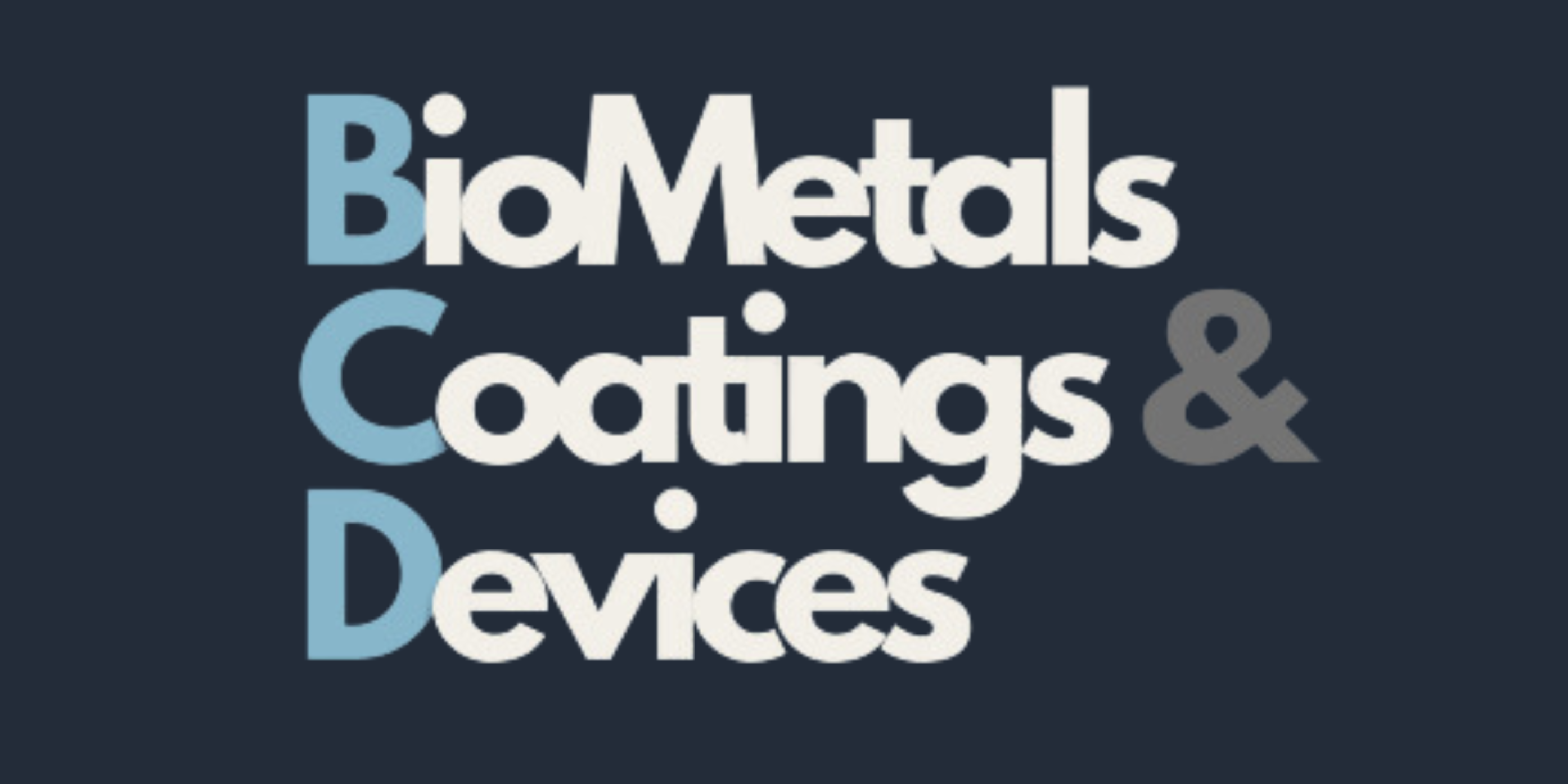Image of the Month - October 2025
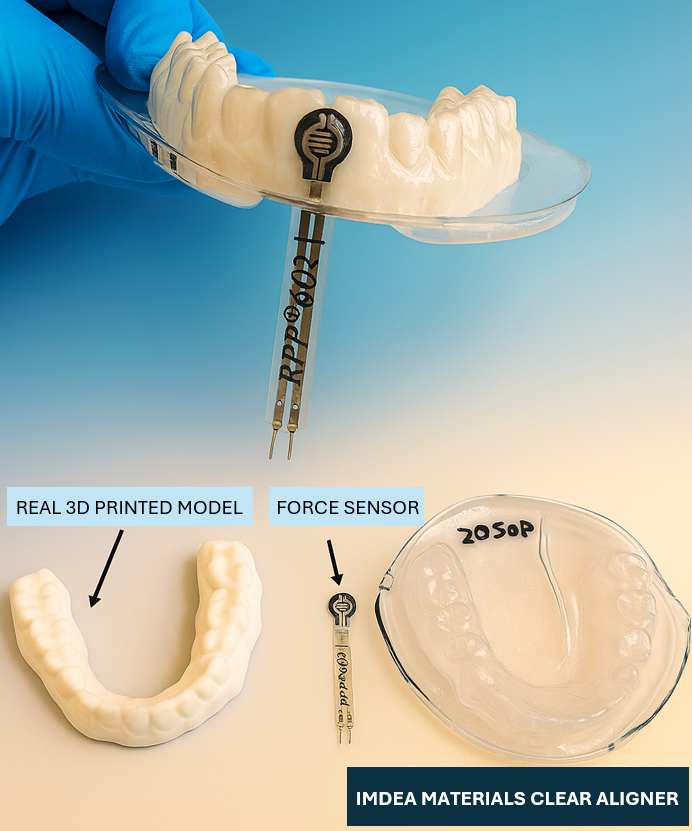
A Bluetooth 4 Teeth
by Ignacio Delgado Castaño
Moving teeth is a force-activated process, but force must be adjusted very precisely to prevent pain or necrosis of soft tissues such as the gum or the periodontal ligament. Even during the restraining phase at the end of treatment, the force should be enough to prevent teeth from returning. Currently, orthodontic devices are designed under a standardized protocol that does not account for individual patients or the materials used in the devices. Not all patients require the same force during orthodontic treatment; therefore, not all devices should be made from the same material.
One of our recent experiments centers on a sensor capable of measuring the force an orthodontic device applies to 3D printed dental models. The sensor was designed using widely available, easy-to-find components, with open-source software based on Arduino and Python to make this technology accessible. An even better feature is the Bluetooth interface that can send data to a smartphone if needed.
Image of the Month - Special Halloween 2025
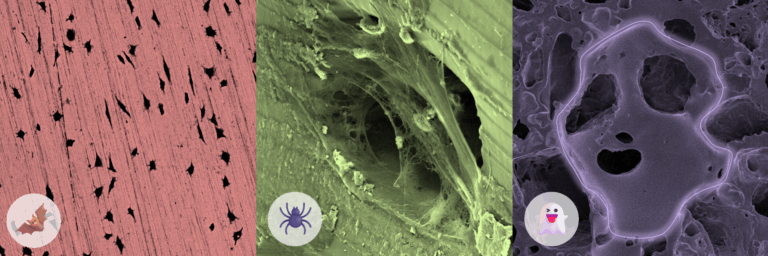



Image of the Month - October 2025
If humans need X-rays, materials do too 🩻
by Luis Calero Lumbreras
This month’s visual captures the inner architecture of a bioabsorbable metal scaffold revealed without a single cut, thanks to X-ray computed microtomography (µCT). Just like doctors rely on radiographs to see inside us, engineers use µCT to see inside materials: to check porosity, strut thickness, connectivity and defects that dictate performance and safe resorption.
In simple terms, µCT is a non-destructive 3D X-ray scan. The sample is rotated and imaged from many angles then powerful algorithms then reconstruct a detailed 3D model at micrometre resolution. That lets us quantify how these scaffolds will carry load, guide tissue growth and gradually dissolve in the body.
At the BCD Group together with the X-ray Characterization of Materials Group lead by Dr. Federico Sket in IMDEA Materials, we combine µCT with a broad suite of characterisation tools (from advanced microscopy and in-situ mechanical testing to thermal and spectroscopic analyses) to give a complete picture of how materials behave, evolve and ultimately perform.
Image of the Month - September 2025

U-Factory robotic arm holding a 3D printed model of bone tissue.
by Aroa Mascaraque León
One of our most recent experiments focuses on degradation studies using polymeric materials. Robotic systems automate the immersion of samples into controlled environments, allowing precise, repeatable cycles that generate large datasets over time. Machine learning then enters the picture, analyzing patterns that remain hidden at smaller scales. This approach is particularly valuable in the study of biomaterials, where understanding degradation and long-term stability is essential for applications such as implants or scaffolds. With robots generating the data and algorithms interpreting it, researchers can explore materials in ways that were previously unreachable.
These robotic initiatives are the result of a collaboration between DIGIMATER Project and the Robotics Laboratory of the Accelerated Materials Discovery group, led by Dr. Maciej Haranczyk, where Aroa Mascaraque León, contribute as a researcher.
Just as films once dreamed of robots shaping the future, today we witness them shaping science itself. No longer confined to fiction, robotics in the lab represents a new chapter-one where mechanical precision and human imagination work together to accelerate discovery.
Image of the Month - August 2025
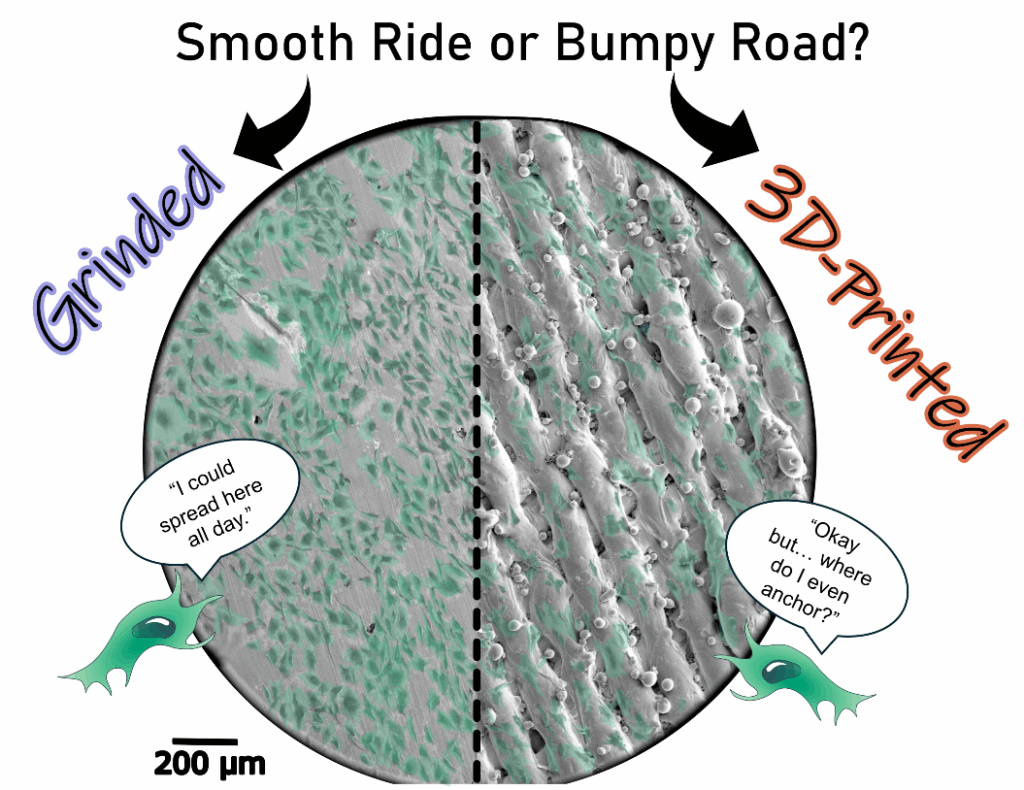
MC3T3-E1 cells cultured for 24 h on HEAs with different surface finishes.
by Francesca Antonella Sepúlveda
in collaboration with Prof. José Manuel Torralba and Dr. Alberto Meza
On the left, a grinded surface provides a flat, uniform landscape. The cells spread widely and adhere smoothly, showing a relatively homogeneous morphology across the surface. On the right, a 3D-printed surface made by laser powder bed fusion presents a more rugged topography. Here, the cells explore valleys and edges, adapting their shape to anchor themselves among the irregularities. These distinctions go beyond appearances. When creating successful biomaterials and bone implants, surface roughness and architecture have a significant impact on how cells adhere, proliferate, and ultimately differentiate.
Under a microscope, what we see represents the start of a complicated biological conversation between material and cell, in which the landscape subtly tells the cell to “stay,” “move,” or “transform.”
Image of the Month - July 2025
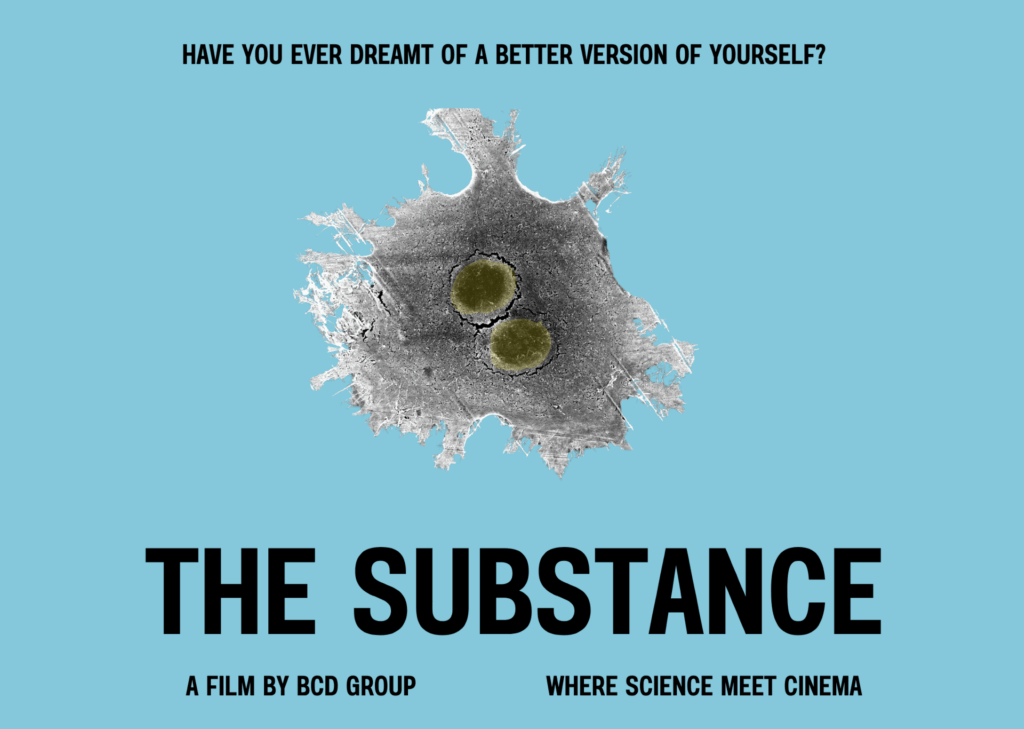
L929 cells cultured for 24h on Zn samples
by Ángela García de la Camacha
We were analysing the results of direct test on Zn samples, one of the methods we use to test the cytocompatibility of the materials we develop. These tests help us understand how cells interact with our materials. The procedure? Cells are seeded directly on top of the samples and incubated under physiological conditions.
In this case, L929 cells were cultured for 24h on Zn samples to assess cell attachment and morphology using Scanning Electron Microscopy (SEM) and what we saw under the microscope caught us completely off guard…
It wasn’t just a cell.
It was THE scene from “The Substance”.
The division scene. The double yolk moment.
“One single injection unlocks your DNA, starting a new cellular division”.
“…a new cellular division”.
EXACTLY! That’s what we were seeing.
Once again, science meets cinema. Because where there is science, there is room for wonder, for story… and, of course, for art.
And in our case, honestly, isn’t this cell dividing so gracefully on our Zn material, as if saying: “This material is so biocompatible that I am ready to multiply”
Worthy of its own Oscar, right?
Image of the Month - June 2025
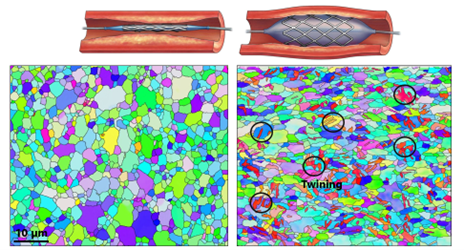
Electron backscatter diffraction map of Zn alloy before (left) and after deformation (right)
by Nafiseh Mollaei
Twinning happens when part of the metal’s crystal structure rotates in such a way that it forms a mirror image within the grain. This creates a twin boundary, a special zone where the atoms are arranged symmetrically but slightly shifted compared to the rest of the grain.
These twins help the metal deform more safely by allowing the grains to change shape more easily. The twin boundaries act like pathways for atoms to move, helping the material absorb the forces applied to it. This prevents cracks from forming and makes the metal more ductile.
By understanding how twinning works, scientists can design zinc stents that are stronger, safer, and more reliable inside the body. It’s a powerful example of how small changes in a material’s internal structure can have a big impact on the success of medical devices.
Image of the Month - May 2025

U87 cell line as a model to study TTF against glioblastoma, real image (Inverted Optical Microscope vs. AI-Generated Image)
by Dr. Monica Echeverry
This month, we want to highlight the use of cell line models and spheroids, spherical clusters of tumor cells grown in controlled environments, which mimic the structure and complexity of real tumors, making them valuable tools for evaluating potential new treatments. These types of biological models are being used in a current project (DITTCe), in which the BCD group is participating, with the goal of developing a new generation of implantable devices based on carbon nanotubes to treat glioblastoma.
Image of the month - April 2025

Graphene Muscle
by Dr. Monsur Islam
The image above shows a muscle cell (highlighted in red) anchored to the porous surface of LIG, demonstrating the biocompatibility and cell affinity of the LIG material. For reference, an image of the LIG material is given at the left corner, highlighting the flexible nature of LIG. With its simple fabrication, flexibility, and broad potential, LIG opens new possibilities for healthcare and medical innovation. This research brings us one step closer to making advanced, customizable materials for healing and beyond.
Image of the Month - March 2025
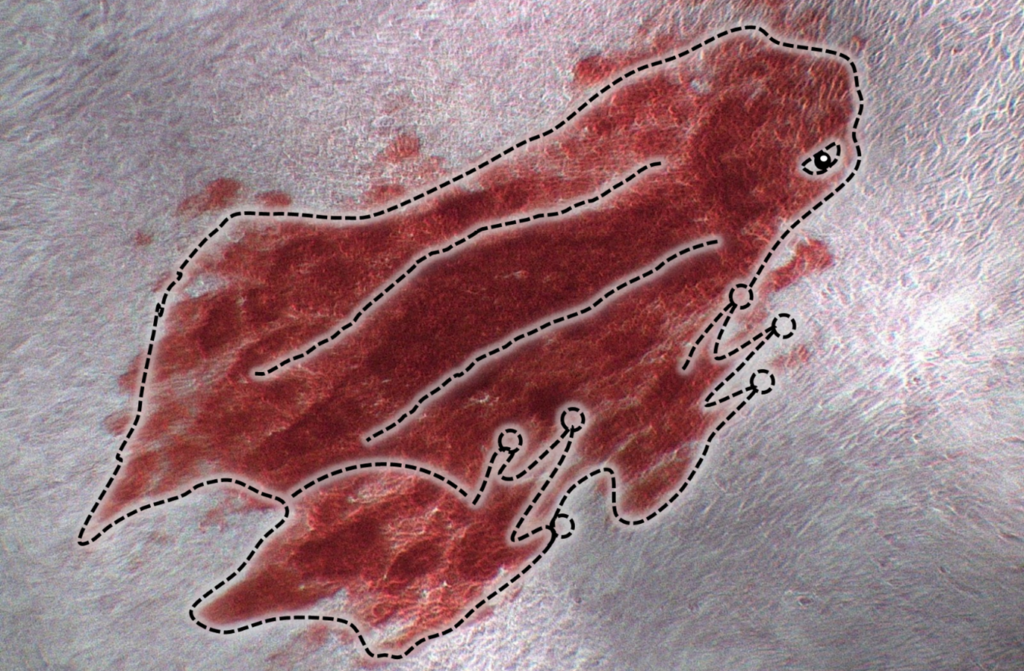
Calcium deposition stained by alizarin red (“frog in the well”)
by Yuyao Liu
In BCD group, we evaluated biomaterials for osteochondral applications, such as magnesium, zinc, titanium, PLA, PCL and so on via different characterizations. Among them, Alizarin Red Stanning is a typical method to check the released calcium deposition during bone regeneration. As shown in the “frog in the well” image, after 21 days of cell culture in osteogenic medium, a dense cell monolayer formed as the background, wherein the frog-like calcium deposition was stained in red, indicating the appearance of successful mineralization. However, “frog in the well” is only a limited vision, we also have PCR to check the expression of osteogenic genes, western blot to check the production of proteins and histological analysis to check the matrix formation, eventually revealing the underlying mechanism of bone regeneration.
Image of the Month - February 2025
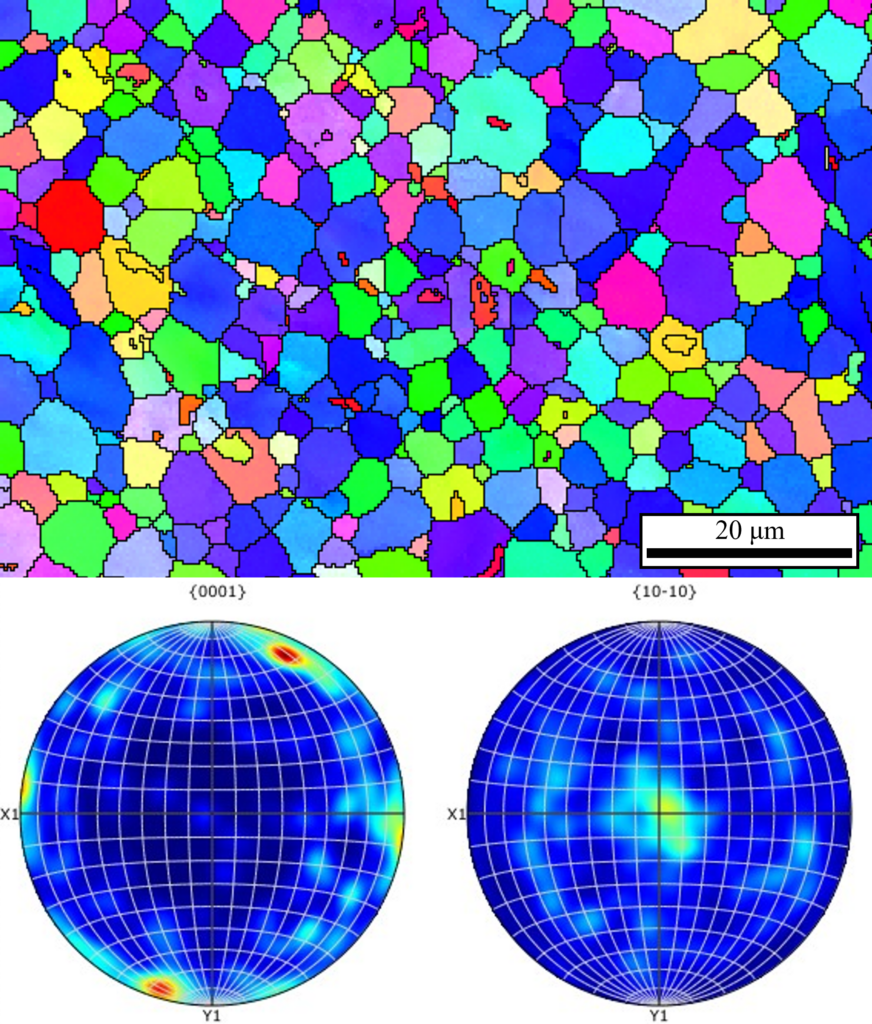
Electron backscatter diffraction map and pole figures of a MgZnCa alloy
by Guillermo Domínguez
These spheres and maps that always go together give valuable information about the metals used in structural applications. With them we can know if the material has its grains (this is how we call the crystalline units in which atoms are organized inside the metals) randomly oriented, or they preferred to orient themselves in a specific direction. This can change dramatically the mechanical properties of a metal, making it suitable for an airplane but useless for a bridge. But this is not all. The grain size and distribution can also change the rate at which a material corrodes, which influences its lifespan. This is the case of the materials that we investigate at the BCD group. The electron backscatter diffraction map and the pole figures (this are the technical names for the colored map and the spheres) show the grain distribution in a magnesium alloy. This Mg alloy has zinc and calcium in its composition. Playing with the Zn and Ca content we can tailor the degradation of Mg by changing the grain size, and therefore try to slow down the fast degradation of a metal that is commonly used in biomedical applications to manufacture medical devices, such as the case of Mg. Metallic microstructures are vital to understand how long a structure or a device will last, and in the field of tissue engineering it becomes important to be sure that the patient won’t suffer new complications.
Image of the Month - January 2025
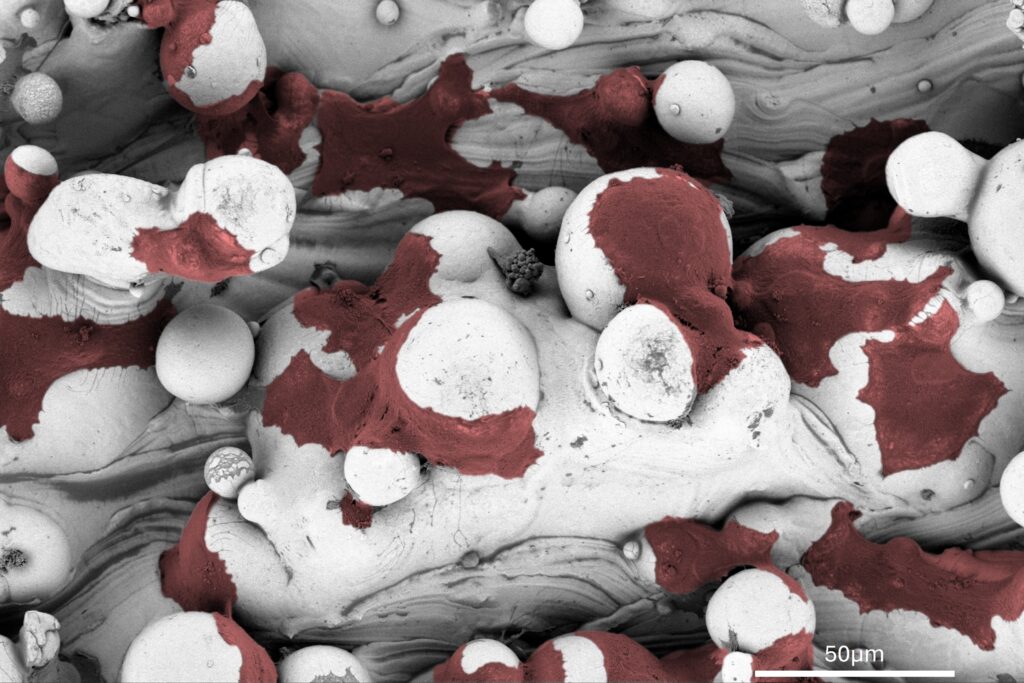
Cells on 3D-printed nitinol surface
By Dr. Jesús Ordoño
Contrary to the wheels of a Mars rover, the nitinol devices that we are fabricating are intended to be implanted in a body’s patient and the interaction of this material with its surrounding tissue, cells or blood is crucial for the success of the intervention. At the BCD group, we perform different surface treatments to improve its properties and device performance, thus achieving a better interaction of nitinol with its surroundings and decreasing the rate of device failure. Improvement of the corrosion resistance and degradability, reduced roughness, enhancement of biocompatibility or even a decrease in inflammatory responses are some of the achievements that our group has successfully obtained using different surface treatments on 3D-printed nitinol cardiovascular devices.
Image of the Month - December 2024
Scaffold in Bioreactor with mechanical load.
Recorded by Yuyao Liu and Guillermo Dominguez.
PLA lattices were fabricated using FFF-based 3D printer by José Luis Jiménez.
Bioreactors are advanced instruments designed to simulate real-life conditions in biological environments while preserving three-dimensional characteristics that are difficult to replicate in traditional cell cultures. These dynamic systems, characterized by constant fluid movement or the addition of electrical and mechanical stimuli, serve as versatile platforms to closely mimic the real physiological environment our materials will encounter in the body. In our BCD group, we currently employ bioreactors to evaluate scaffolds for osteochondral tissue engineering and cardiovascular applications.
Image of the Month - November 2024
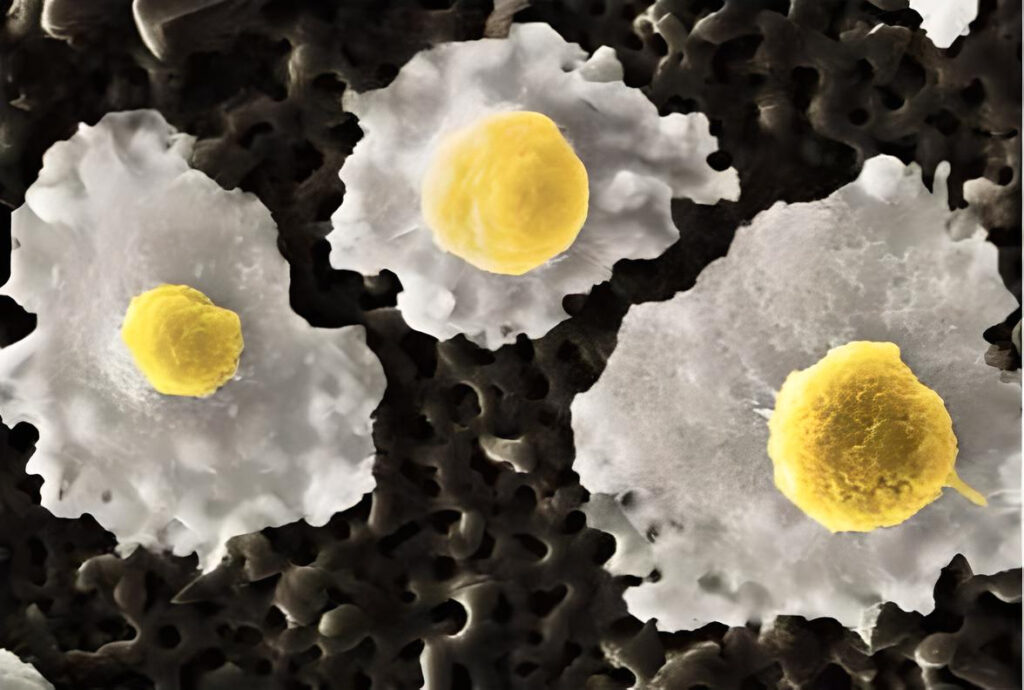
Summer in Madrid.
By Dr. Monica Echeverry-Rendon
In August 2021, a severe heat wave hit Spain, with reports claiming that cement temperatures reached up to 60 °C. Under such conditions, it was even possible to fry an egg in the sweltering midday sun. The image depicts a human osteoblast (Saos-2) attached to a titanium surface modified through plasma electrolytic oxidation. Titanium (Ti) is widely used in biomedical applications due to its excellent mechanical properties and high biocompatibility. Surface modification has become a promising approach to enhancing the osseointegration of titanium in orthopedic and dental applications. Plasma electrolytic oxidation (PEO) is an electrochemical technique that, by controlling parameters such as voltage, current, electrolyte composition, and reaction time, enables the creation of various surface morphologies and configurations. These modifications have a direct impact on cellular behavior, ultimately improving tissue-material interactions.
